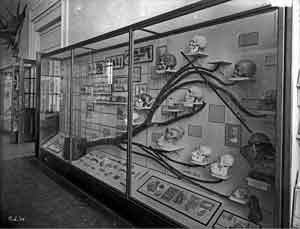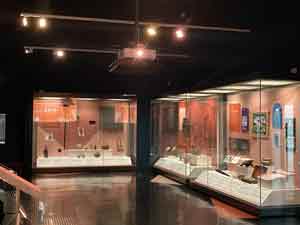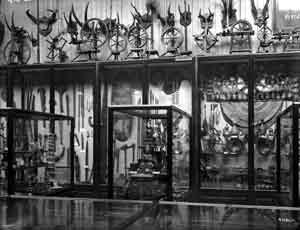COLONIALISM, EMPIRE AND INCLUSIVE GLOBAL HISTORIES
Published in Issue 4 (July/August 2022), Reviews, Volume 30Ulster Museum, Botanic Gardens, Belfast
By Briony Widdis
On 31 March 2022, National Museums NI launched Inclusive Global Histories at the Ulster Museum. Developed with the support of Michelle McIntyre-Brewer as Cultural Liaison, and through collaboration with local citizens and organisations, the exhibition indicates institutional commitment to decolonisation and to confronting contemporary racism.
According to Jonathan Wright, collectors for the Belfast Natural History and Philosophical Society ‘thought in global terms’. No interior photos of its Belfast Museum, opened in 1831 on College Square North, have survived, but those of the separate Belfast Art Gallery and Museum, opened in 1890 on Royal Avenue by the Town Council (opposite page, top), show the typological approach to ethnographic items within that institution. In addition, there are photos of the Council’s Belfast Museum and Art Gallery on Stranmillis Road, which from 1929 exhibited the combined collections of these two predecessors. There, in an ‘Ascent of Man’ case, a skull that appears especially white in colour is placed at the pinnacle of an evolutionary display representing ‘living races’ (see below).
This image illustrates how the Museum conformed to the racist constructions of museums across the British Empire at that time. The dominance of Western epistemologies is further suggested by how, whereas European artefacts were moved to Hillsborough Castle for safe keeping during the 1941 bombing of Belfast, ethnographic collections were left in situ at the Museum or were stored in a concrete room under a bridge on Tate’s Avenue. Items not removed from that location until the late 1960s included a North-west Coast frontlet, ivory and human hair necklaces from Hawai’i and, from the Māori people in New Zealand, two tāniko (twined) cloaks and a model canoe, left hanging from the roof (Winifred Glover, pers. comm., 2018).
In his 1979 history of the institution, Noel Nesbitt mentions the ethnographic collection with reference to its nineteenth-century origins and to the 1925–9 construction of what would become the Ethnography Gallery, giving the impression that by the time of his writing it had come to be regarded as somewhat anomalous. The 1962 renaming of the Belfast Museum and Art Gallery as the Ulster Museum, accompanying its hand-over from Belfast Corporation to a new board of trustees, had signalled its six- (or nine-) county aspirations. According to current Director of Collections William Blair, the 1972 proroguing of the Stormont parliament, removing the Museum from local control, had afforded political space for its liberal-minded curators—including, for example, the poet and Keeper of Art John Hewitt—to further develop the diversity of the collections. This argument is affirmed by the fact that Winifred Glover, ethnographic curator from 1978 to 2012, had the freedom not only to continuously exhibit the collection but also to reference its problematic nature. She stated, for example, that some collectors’ engagements with rightful owners had been driven by ‘no humanitarian motive’.
That she was able to make this point, though, may, in addition to indicating that there was no particular desire at senior levels for editorial control, suggest that there was also a laissez-faire attitude to the institution’s colonial collection. In conversations with me, Winifred has stated that during the 1970s and 1980s she had repeatedly to defend the collection against sale to fund Irish acquisitions, and that some senior staff were solely interested in an atua from Rapa Nui (Easter Island) because it is one of only three in the world, and a Hawai’ian cloak, thought to have been purchased from King Kamehameha III by Gordon Augustus Thomson. Their partiality for prestigious items has echoes in how her own publications focus on the ‘wealthy members of society [who] socialised together’ in Belfast.

Above: The ‘Ascent of Man’ case in the Natural History Gallery of the Belfast Museum and Art Gallery, Stranmillis Road, c. 1929.
All images: National Museums NI
At the time, moreover, local understanding of source community rights and interests was limited: her 1978 exhibition, Land of the Brave, was popular because ‘people remember playing cowboys and Indians from an early age and also from seeing them portrayed in films’. Audience response to exhibitions of Polynesian, Melanesian and African items (1979, 1980 and 1982) was, by comparison, ‘low-key’ and ‘unmoved’, except in relation to a Māori mokomokai (tattooed head), ‘which elicited the same sort of grisly interest usually reserved for the Egyptian mummy’.
This short review has explored some influences on the twentieth-century interpretation of the National Museums NI ethnographic collections and has provided historical backdrop for the reframing that is now taking place. Winifred Glover’s focus on collector biographies was produced by a working environment that, although internally tranquil, was situated in a society in conflict. This context favoured a concentration on local identities and histories, and on items that would attract positive publicity for the Museum and its role in Northern Ireland. Glover’s strategy of celebrating individuals from Ulster also met the expectations of an audience conditioned by the mass ‘othering’ of indigenous groups in Western media. Through this politically expedient approach, she sustained the collection, paradoxically laying the foundations for the decentring of élite and Western narratives that is so essential to museum decolonisation in the present.
Briony Widdis is an Economic and Social Research Council (ESRC) post-doctoral fellow in the Centre for Public History, Queen’s University, Belfast.


















